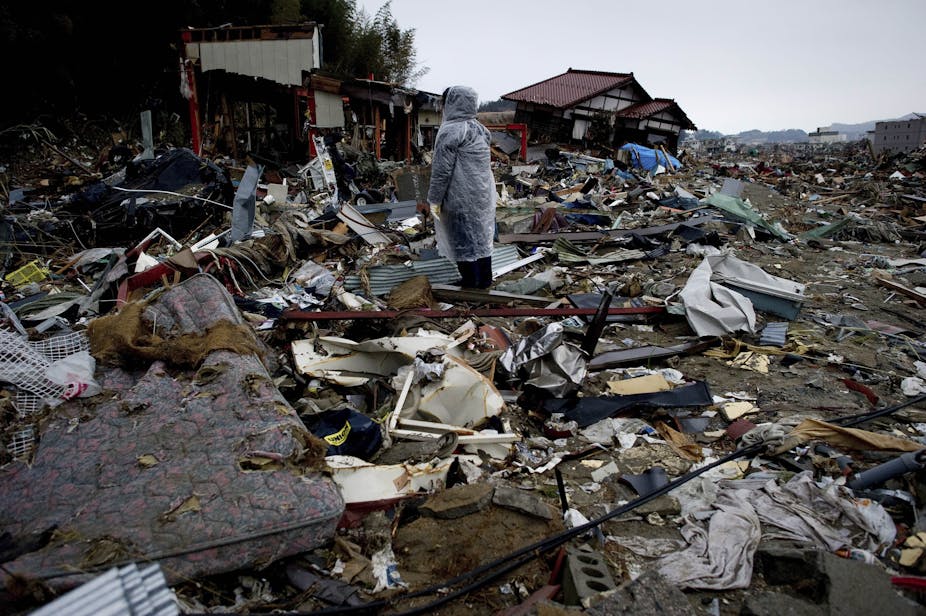In the wake of the Queensland floods, the Christchurch earthquake, and the Japanese earthquake/tsunami/nuclear crisis, people are asking for advice about how we should manage the effects of disaster on mental health. Many people offer opinions to media, policy makers, and survivors on this issue but much of this advice is ill-informed.
We have learnt a great deal in recent years about how people tend to respond to disasters and this has pointed us in the direction of how we should assist people.
In the initial weeks after a major event, many people experience distress, including anxiety, distressing memories, sleep disturbance, nightmares, and restlessness. This is very common and is an understandable reaction to stress.
We also know, however, most mental health problems typically reduce over time. As people learn that the threat has passed, they typically get over the initial distress. Several months after a disaster, most people are able to psychologically adapt and recover. However, there is usually a significant minority who will have persistent problems.
There are exceptions to this rule too. A study after Hurricane Katrina found that mental health problems in New Orleans actually increased as time progressed, probably because people’s resources were worn down by the ongoing stress caused by delayed rebuilding, community recovery and ongoing financial strain.
The possibility that mental health problems can increase over time highlights an important point in disaster response. Most people consider the immediate threat of tsunamis washing people away or buildings falling on people as the source of trauma. In actual fact, the greater source of persistent distress comes from the more subtle long-term effects of disasters.
When economies are undermined by infrastructure damage, the effects on people can last for years. In many large-scale disasters in recent years, such as in the 2004 tsunami or the Pakistan earthquake, already fragile economies were shaken by the disaster, and as a result the capacity for people to work and for communities to sustain an adequate level of productivity was severely undermined.
This can result in insidious rises in depression, anger, and conflict as people cannot earn enough income and communities cannot rebuild. In this sense, the mental health effects of a disaster can be felt for years afterwards, even though the causal link between the disaster and the observed mental health problems may not be obvious.
At this point, it is difficult to estimate the mental health fall-out from the Japanese crisis but the level of destruction and the lingering effects of the nuclear event suggests that direct and indirect effects will be felt for many years to come.
For decades, people have thought that the best way to respond to a disaster was to provide counselling. There are countless stories of hundreds of trauma counsellors converging on disasters sites in the days and weeks after a disaster to talk to survivors. This approach is based on the premise that people are essentially vulnerable and require psychological assistance, and that by discussing one’s experiences in the immediate wake of a trauma there will be mental health gains. Neither of these presumptions has been proven to be true.
Accordingly, recent developments have altered how government agencies respond to disaster. A major turning point was the response to the mental health needs of people affected by Hurricane Katrina. An innovative mental health response program was established after Katrina, called Skills for Psychological Recovery (SPR). SPR was prepared to assist counsellors across the United States in delivering appropriate interventions that addressed the main needs of people after a disaster.
This protocol was not intended as a first response, but rather to assist people with ongoing problems who were seeking assistance in the weeks and months after Hurricane Katrina. It was not an intervention for people with diagnosable disorders, but rather an intermediate step to address the range of significant psychological issues that typically arise. The program was based on evidence-supported strategies that have been proven to reduce the major problems evident after disasters.
In the aftermath of the Black Saturday fires in Victoria, this approach was adapted in a stepped approach that involved three levels, by the Victorian Department of Health Services and the Federal Department of Health and Ageing. Global support was offered to all survivors that intended to provide information, social support, and referral if necessary. SPR was then provided to those who felt they had lingering problems in the months afterwards. Finally, the minority who had specific mental health problems received specialist treatment. Many health professional were trained across Victoria in these skills, and this co-ordinated approach appears to have been a significant advance over previous disaster responses.
There is no doubt that disasters will continue to occur, and often affect large numbers of people. Most people will be resilient and will not need assistance. Some people will need assistance, and it is important that they are provided with programs based on evidence that can promote recovery.

